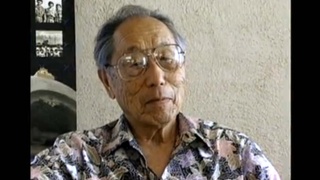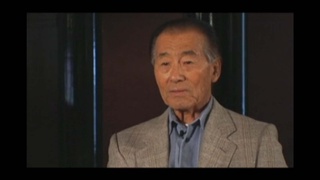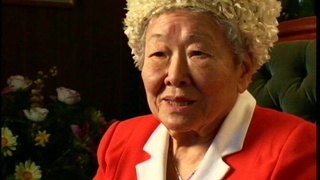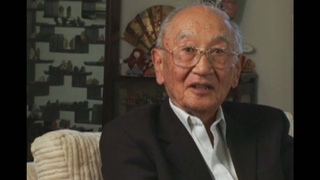Entrevistas
The horror of Hiroshima after the atomic bombing (Japanese)
(Japanese) When I entered into the city of Hiroshima, there were just bodies wrapped in cloth all over the streets. In the river, there still were floating corpses. Yes. That was… (inaudible). Because the area was completely flattened out, we all at first thought that maybe this was due to a huge earthquake, and not the effects of a bombing. But then, after a while, we realized it wasn’t from an earthquake. What could it be? Then, of course, the next day we found out about this thing called the atom bomb.
Yes, we walked and walked, for half a day we walked to the other side of a Hiroshima (train) station. Hmm, the name of the station… is recorded somewhere here, but yes, we walked there. So we’re at this station in Hiroshima—I still remember this. Was it about sundown? We finally stopped to eat some nigiri-meshi (rice balls), and I think it was either a little bit cloudy or raining… For some reason, something, I’m not sure, it was a feeling beyond any man’s imagination—I was overcome with this complete sorrow that I could not even begin to put into words.
So I really experienced the truly horrifying effects of an atomic bomb, and I do tell others that nuclear weapons should never, ever be used again. The experience that my heart went through was just…
Later on, I returned to my convoy and we found out that the atomic bomb had been dropped on August 6th. We had gone through the city just 36 hours after it. So I avoided direct impact, but of course, the radiation took its toll on my body, and I have this condition called pulmonary emphysema—I lose my breath quite easily now. The doctor tells me that it’s probably due to the effects of radiation poisoning...
Fecha: June 17, 2008
Zona: California, US
Entrevista: Yoko Nishimura
País: Watase Media Arts Center, Japanese American National Museum
Explore More Videos

La apariencia vs. La efectividad en el combate (Inglés)
(1919 - 2006) Veterano de la Segunda Guerra Mundial y Guerra de Corea

Would do the same again
(1916-2010) Recluta disidente, ayudó a formar el Comité Heart Mountain Fair Play

El entrenamiento básico (Inglés)
(1919 - 2006) Veterano de la Segunda Guerra Mundial y Guerra de Corea

Una visita a Jerome después de la Escuela de Aspirantes a Oficial (Inglés)
(1919 - 2006) Veterano de la Segunda Guerra Mundial y Guerra de Corea

Lograrlo por todos los asiáticos (Inglés)
(1919 - 2006) Veterano de la Segunda Guerra Mundial y Guerra de Corea

Retrato horrible de la guerra (Inglés)
(1919 - 2006) Veterano de la Segunda Guerra Mundial y Guerra de Corea

Experiencia cercana a la muerte (Inglés)
(1919 - 2006) Veterano de la Segunda Guerra Mundial y Guerra de Corea

La fe del General Ryder en el 100˚ batallón de infantería (Inglés)
(1919 - 2006) Veterano de la Segunda Guerra Mundial y Guerra de Corea

Cómodo en el combate (Inglés)
(1919 - 2006) Veterano de la Segunda Guerra Mundial y Guerra de Corea

Lost respect for the flag after incarceration
(1913-2013) Doctor, especialista en obstetricia en California del Sur

Traumatic experiences before camp
(1913-2013) Doctor, especialista en obstetricia en California del Sur

Joining the hospital unit in Santa Anita Race Track
(1913-2013) Doctor, especialista en obstetricia en California del Sur

“Everybody went in like sheep”
(1913-2013) Doctor, especialista en obstetricia en California del Sur

Finding out Roosevelt wanted Japan to attack
(1919-2020) Miembro del Batallón de Ingenieria 1800. Promovió el comercio japonés americano mientras trabajaba en la división de exportación de Honda

Parents expected to be taken by the FBI
(1919-2020) Miembro del Batallón de Ingenieria 1800. Promovió el comercio japonés americano mientras trabajaba en la división de exportación de Honda
